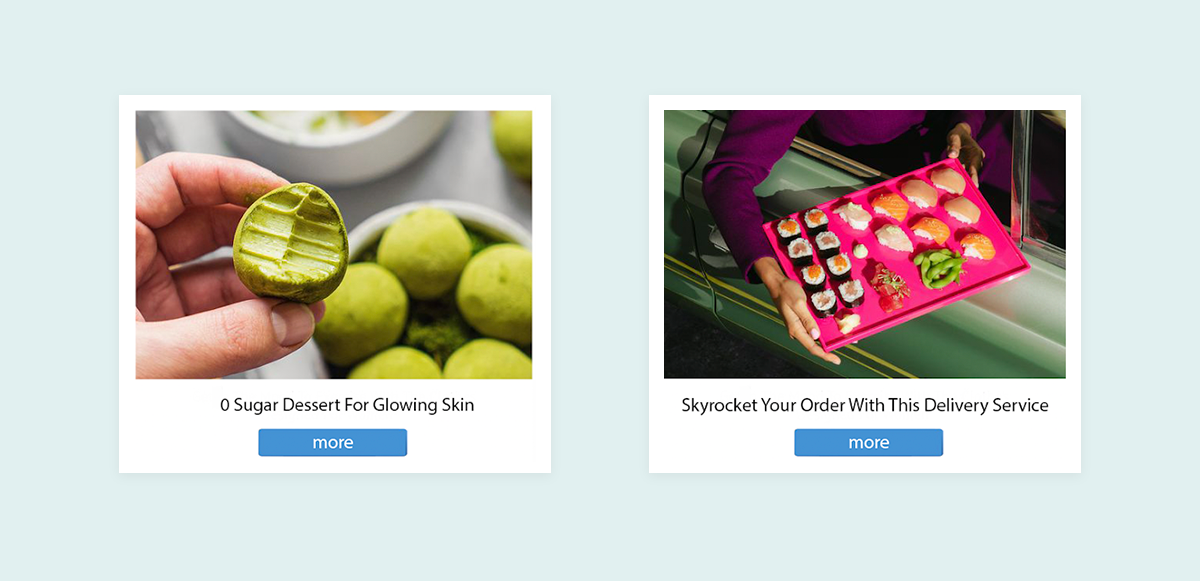For many years, marketing experts have focused on delivering mobile-friendly ads on our mobile-friendly websites. However, seeing as how 63% of all organic Google searches in 2021 originated on mobile devices, it might be time to stop treating mobile as some secondary market that we adjust our desktop strategies to. It’s about time we started building our marketing campaigns with a mobile-first mindset, and that includes porting the immensely successful native advertising to mobile.
So let’s delve into the key considerations, best practices and actionable tips for creating effective native ad campaigns that resonate with mobile users.
What Are Mobile Native Ads?
Mobile native ads refer to advertisements that are specifically designed and optimized for mobile devices. These ads are typically customized to match the visual style, format and functionality of the mobile platform on which they are displayed.
The key characteristic of mobile native ads is their ability to provide a native, non-intrusive user experience while still delivering the advertising message.
Types of Mobile Native Ads
The main types of mobile native ads include:
- In-feed ads. These ads seamlessly blend into the content feed of a mobile app or website. They appear as sponsored posts or articles within the natural flow of content, often labeled as "sponsored" or "recommended."
- App install ads. These ads promote the installation of a specific mobile app. They are usually displayed within other mobile apps, offering users the opportunity to download and install the advertised app directly from the ad unit.
- Native video ads. These are video advertisements that are integrated into the mobile app or website's content stream. They automatically play or require user interaction to initiate playback, offering an immersive video ad experience on mobile devices.
- Sponsored listings. These ads appear as promoted listings or search results within mobile apps or websites. They are commonly used in e-commerce or directory platforms, where advertisers pay to have their products or services prominently displayed.
- Sponsored stories. These ads leverage the user-generated content or social media feeds of mobile apps to deliver personalized and relevant advertisements. They appear as stories or updates within the app's interface and can be targeted based on user interests and behaviors.
- Custom native ads. These ads are custom-designed to match the visual style and functionality of a specific mobile app or website. They are highly tailored to the app's user interface and offer a seamless integration with the overall design and user experience.
The availability and specific types of mobile native ads may vary depending on the advertising platform, app or website. Advertisers and publishers can choose the most suitable types of mobile native ads based on their campaign goals, target audience, and the platform's native ad offerings.
How do Mobile Native Ads Work?
Mobile native ads work by seamlessly integrating promotional content into the user experience of mobile apps or websites. Being native ads, they are targeted based on factors like user demographics, interests, browsing behavior, and app context.
Mobile native ads can offer different levels of user interaction. Users may have the option to click on the ad for more information, engage with interactive elements, watch videos, or take specific actions like app installations or making purchases.
Mobile-Specific Ad Creatives
By building ad creatives specifically for mobile, you’ll be able to integrate native advertising seamlessly. Below we provide some recommendations with examples of creatives designed by our specialists. You can also benefit from unique creatives at no cost from our team if you choose to join our advertiser community.
For starters, start by cutting down on excess text in your copies. As you know, copies were already fairly short and succinct to begin with. Now that we’re slowly transitioning to mobile-specific strategies, it’s time to make copies bite-sized.

Ad creatives that feature the specific device a user is currently on are a great way to point out that the ad is made for those viewing it. However, that’s not the only way for you to include your users in the creatives. Make ads that show all the different ways in which people handle their phones including various angles, one hand or both, and phone decoration.

The setting can also make for interesting ad creatives. Use a background that portrays where the person is using their device. Creatives that show using devices in the bedroom, park, or public transportation all work well in establishing the connection between the user and the creative.

Creative editing is one of the most successful mobile-specific strategies for native advertising. Your options are virtually limitless, allowing you to make truly outstanding ads that integrate with mobile device ecosystems in unique ways. For example, cropping objects that arouse attention and hiding them behind swipeable native ads will get users to interact with your creatives more.
Moreover, using photoshop can result in some really mind-bending creatives the users will appreciate and play with. You can experiment with photoshop to your heart’s content, and the users will recognize your effort in creating an experience like no other before.

Last but not least, don’t be afraid to have some fun with the users. It’s the internet, after all, so making an ad creative that features a funny picture of a cat and a motivational quote is never out of the question.
Whatever you do, make sure that the focus of your creatives is clear. Too many objects or characters (or messages) can only confuse the user. Bright colors and shapes can accentuate the focus of the ad and portray its intent.
Advantages of Mobile Native Ads
In addition to the classic advantage of seamless integration into the content of the app or website, mobile native advertising can boast the same advantages as desktop native advertising. And although you are probably familiar with all this, we will brush up on them:
- Higher user engagement. Native ads are designed to be more engaging and interactive. By offering relevant and contextual content, native ads are more likely to capture users' attention and drive meaningful interactions, such as clicks, downloads or conversions.
- Improved user experience. Since native ads are integrated within the app or website's interface, they contribute to a better overall user experience. Instead of interrupting or annoying users, native ads provide valuable and relevant content that aligns with their interests.
- Enhanced relevance and targeting. Mobile native ads leverage advanced targeting capabilities to ensure they reach the right audience. Advertisers can target users based on demographics, interests, browsing behavior, and app context.
- Higher conversion rates. The seamless integration, contextual relevance and engaging nature of mobile native ads can result in higher conversion rates. When users are presented with ads that align with their interests and seamlessly fit into their user experience, they are more likely to take the desired actions.
- Increased advertiser ROI. Due to their higher engagement and conversion rates, mobile native ads often deliver a higher return on investment (ROI) for advertisers.
Recommendations for Landing Pages
Native advertising landing pages don’t need to hard-sell a product or a service. They do so in a manner that’s natural, informative, and highly valuable to the user. Likewise, mobile-specific strategies for landing pages that convert need to be natural and interactive, on a version of the site suited to the device.
Here are some more proven recommendations to help you create an effective mobile landing page:
- Interactivity. It is one of the pillars of successful mobile landing pages. Users expect that kind of behavior on mobile and can be disappointed by the lack of it. Interactivity translates well to entertainment, which is at the core of mobile devices.
- Entertainment. You need to consider how users tend to entertain themselves and apply that design to landing pages. Social media, for one, is mostly accessed on mobile. Mimicking the style and function of social media platforms will make your landing pages seem completely familiar to the user and grab their attention.
- User experience. It is by far the most crucial aspect of successful landing pages. Make every last detail of your page with convenience in mind — use soothing colors and tones, large readable fonts, and easy-to-press buttons independent of the screen size or user’s handedness.
- Live dialogue. Strike a simple and sincere conversation with your target audience. Overused marketing jargon is as outdated as banner ads and just as successful at repelling prospects.
In pursuit of creativity, do not forget about the technical side of the issue. Mobile users expect instant access to information. Optimize your landing pages for speed by minimizing file sizes, compressing images and reducing unnecessary code.
Rethinking Native Ads for Mobile
Native advertising is the digital ad format that we’ve been heading towards for quite some time now, whether we knew it or not. It’s the culmination of user dissatisfaction with intrusive ads, banner blindness, and the incompatibility of current ad models. So, if native ads are an evolution of advertising, why is their integration into mobile so slow and inefficient?
The reasons vary, but it all seems to boil down to standardization issues. The industry is stuck in the rut of servicing the same types of ad units over and over again since their creative elements are easy to predict. We’re talking about native ads on desktop websites where the layout is mostly the same, making the standardization a real no-brainer.
While native ads on desktop websites only need to match the editorial style and tone of the content, native ads for mobile need to match the function of media as well. In other words, creative assets need to match the specific environment they are in while performing a similar function.
Current standardization does not consider creative elements such as games within games or notification-like ads in messaging apps. When the paradigm shifts from mobile-friendly to mobile-first, we’ll be able to discuss true mobile-specific native advertising.
Final Thoughts
Native advertising for mobile is an endless creative landscape that’s still waiting to be discovered. To truly conquer the mobile-specific ad space, you need to change the way you think about mobile ads. No more adapting desktop ad units to mobile — it’s time to go mobile-first.





